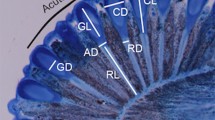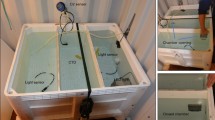Abstract
Fish biologists have shown little interest in near-infrared (NIR) sensitivity because water absorbs light in the red and near-infrared and because downward irradiance in clear ocean water is mostly blue light. In recent years, however, Nile tilapia Oreochromis niloticus was shown to be NIR sensitive by behavioral techniques. This study confirmed NIR sensitivity in the common carp Cyprinus carpio and Nile tilapia by using a more sensitive technique than a behavioral one. Cardiac conditioning experiments showed that both fishes are sensitive to 865 nm NIR. The conditioned response to 865 nm NIR was observed in Nile tilapia when the eyes were not covered and the pineal window was covered, but not when the same fish had its eyes covered and the pineal window exposed to the NIR. The eyes are thus, the NIR-sensitive organs in Nile tilapia. To identify the NIR photoreceptor, the retina was examined by histology. The retina exposed to 865 nm NIR showed incomplete dark adaptation with rods exposed from retinal epithelial pigment. Though the reaction to NIR seemed to be mediated mainly by the red cone, the involvement of the rod could not be ruled out.
Similar content being viewed by others
References
Jerlov NG, Kinne O (ed). Marine Ecology. Vol. 1 Environmental Factors, Part 1. Willey, London, New York, Sydney, Toronto. 1970; 95–102.
Griffin DR, Hubbard R, Wald G. The sensitivity of the human eye to infra-red radiation. J. Opt. Soc. Am. 1947; 37: 546–554.
Brindley GS. The colour of light of very long wavelength. J. Physiol. (Lond.) 1955; 130: 35–44.
Baylor DA, Nunn BJ, Schnapf JL. Spectral sensitivity of cones of the monkey Macaca fascicularis. J. Physiol. (Lond.) 1987; 390: 145–160.
Kobayashi R, Endo M, Yoshizaki G, Takeuchi T. Sensitivity of tilapia to infrared light measured using a rotating striped drum differs between two strains. Nippon Suisan Gakkaishi 2002; 68: 646–651.
Endo M, Kobayashi R, Ariga K, Yoshizaki G, Takeuchi T. Postural control in tilapia under microgravity and the near infrared irradiated conditions. Nippon Suisan Gakkaishi 2002; 68: 887–892.
Nishi T, Kawamura G, Matsumoto K. Magnetic sense in the Japanese eel, Anguilla japonica, as determined by conditioning and electrocardiography. J. Exp. Biol. 2004; 207: 2965–2970.
Kawamura G, Shibata A, Yonemori T. Response of teleosts to the plane of polarized light as determined by the heart rate. Nippon Suisan Gakkaishi 1981; 47: 727–729.
Rommel SA, McCleave JD. Oceanic electric fields: perception by American eels? Science 1972; 176: 1233–1235.
Siegel S, Castellan NJ. Nonparametric Statistics for the Behavioral Sciences. McGraw-Hill Book, New York, 1988.
Ali MA. Retinomotor responses. In: Ali MA (ed). Vision in Fishes. Plenum, New York, London. 1975; 313–355.
Govardovskii VI, Fyhrquist N, Reuter T, Kuzmin DG, Donner K. In search of the visual pigment template. Vis. Neurosci. 2000; 17: 509–528.
Mooij JEM, van den Berg TJTP. The spectral shape of A2 visual pigments. Vision Res. 1983; 23: 701–705.
Stiles WS. The physical interpretation of the spectral sensitivity curve of the eye. In: Transactions of the Optical Convention of the Worshipful Company of Spectacle Makers. Spectacle Makers Company, London. 1948; 97–107.
Ali MA, Wagner HJ. Visual pigments: phylogeny and ecology. In: Ali MA (ed). Vision in Fishes. Plenum Press, New York. 1975; 481–516.
Ebrey TG, Honig B. New wavelength dependent visual pigment nomograms. Vision Res. 1977; 17: 147–151.
Dewan S, Saha SN. Food and feeding habits of Tilapia nilotica-(L) (Perciformes: Cichlidae). 2. Diel and seasonal patterns of feeding. Bangladesh. J. Zool. 1979; 7: 75–80.
Boujard T. The circadian rythms of feeding activity in teleosts species. Cybium Suppl. 1999; 23: 89–112.
Lythgoe JN. The Ecology of Vision. Clarendon Press, Oxford, 1979.
Richards EA. Contrast-enhancement in imaging devices by selection of input photosurface spectral response. Adv. Electron. Electron. Phys. 1969; 28B: 661–675.
Walls GL. The Vertebrate Eye and Its Adaptive Radiation. Hafner Publishing Company, New York. 1967.
Clarke GL, James HR. Laboratory analysis of the selective absorption of light by sea water. J. Opt. Soc. Am. 1939; 29: 43–55.
Burt WV. Selective transmission of light in tropical Pacific waters. Deep-Sea Res. 1958; 5: 51–61.
Jerlov NG. Marine Optics. Elsevier Scientific Publishing Company, Amsterdam. 1976.
Author information
Authors and Affiliations
Corresponding author
Rights and permissions
About this article
Cite this article
Matsumoto, T., Kawamura, G. The eyes of the common carp and Nile tilapia are sensitive to near-infrared. Fish Sci 71, 350–355 (2005). https://doi.org/10.1111/j.1444-2906.2005.00971.x
Received:
Accepted:
Issue Date:
DOI: https://doi.org/10.1111/j.1444-2906.2005.00971.x




